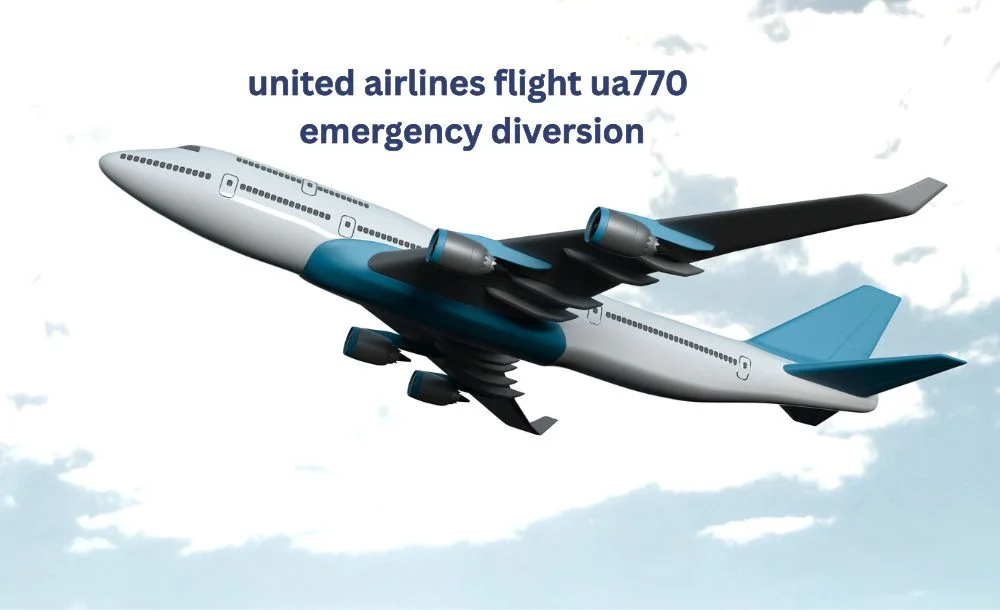In the ever-moving world of modern air travel, every flight tells a quiet story. While most journeys unfold without a ripple, some moments gently shift the path of a plane not out of panic, but out of a quiet and calculated sense of care. The United Airlines Flight UA770 emergency diversion is one such moment, subtle yet meaningful, reminding us that the strength of aviation lies in preparedness, not just performance. This incident didn’t shout for attention. Instead, it quietly highlighted how airline systems pilots, crew, and ground teams come together when the unexpected arises. From passengers calmly rerouted to a plane guided safely toward an alternate destination, Flight UA770’s diversion was not a disruption, but a delicate detour with safety at its core.
A Flight like Any Other until It Wasn’t
United Airlines Flight UA770 began its journey like thousands of other commercial flights do every day. The boarding process, the pre-flight checks, the safety instructions all part of a well-rehearsed rhythm. Passengers settled into their seats, perhaps checking their phones, adjusting travel pillows, or mentally preparing for the hours ahead. As the aircraft climbed into its cruising altitude, everything appeared to be in perfect order. The skies offered no resistance, and the hum of engines lulled the cabin into quiet. But somewhere along the journey, a decision quietly formed in the cockpit: a course correction was necessary not out of alarm, but out of caution. What followed was the United Airlines Flight UA770 emergency diversion, a maneuver that unfolded with the very grace that characterizes trained aviation professionals. Passengers were informed. The flight path changed. And preparations for an unexpected landing were initiated without drama.
Why Flights Divert a Soft Look behind the Decision
When a flight diverts, it often leads to questions: What happened? Was it serious? Could it have been avoided? In most cases, the answers are grounded in care. Diversions may occur due to mechanical concerns, sudden passenger illness, weather complications, or airspace restrictions. In the case of United Airlines Flight UA770, official reports may or may not disclose full details, but the very act of diverting reflects one thing with certainty vigilance. Pilots do not make these decisions lightly. When they do, it is the result of thoughtful assessment. Whether prompted by a potential irregularity in the aircraft’s systems or a call to prioritize a passenger’s health, these diversions are executed to ensure that safety is never compromised.
The Role of the Crew Calm in the Skies
During a diversion, flight attendants play an essential role not just in logistics, but in tone. Their calm communication can mean the difference between a tense cabin and a composed one. On Flight UA770, reports indicated that the crew remained reassuring, gently explaining the situation and addressing concerns with patience and poise. This human touch is often overlooked in discussions of aviation. Behind uniforms are individuals trained to respond not just with technical knowledge, but with empathy. They understand that even a small deviation can cause anxiety, and they carry the responsibility of turning concern into calm. In moments like these, the crew’s professionalism becomes as visible as the wings outside the window.
The Passenger Experience from Surprise to Safety
For passengers aboard United Airlines Flight UA770, the announcement of an emergency diversion likely came as a surprise. Some may have exchanged worried glances, while others quietly accepted the change. There may have been questions; uncertainty about onward travel, or minor inconveniences but the prevailing sentiment was one of understanding. Many travelers today recognize that diversions are part of a wider safety framework. Airlines like United have built reputations not just on punctuality or comfort, but on reliability when it matters most. The handling of Flight UA770’s emergency diversion only strengthened that perception. Once landed, passengers were assisted in rebooking or continuing their journeys. The process wasn’t chaotic it was measured. And though not part of the original itinerary, it reminded everyone that reaching one’s destination safely is the true measure of a successful flight.
How Ground Operations Support a Smooth Diversion
While the aircraft adjusted its path in the air, teams on the ground sprang into action. Air traffic controllers coordinated the revised approach. Maintenance crews prepared for inspection. And airport staff organized services for passengers who would soon be arriving at an unexpected terminal. This level of coordination is not spontaneous it’s rehearsed, refined, and constantly updated to meet changing conditions. The United Airlines Flight UA770 emergency diversion demonstrated how smoothly the invisible gears of air travel can turn when needed. Even the choice of where to divert involves strategy. Factors like runway length, weather, airport facilities, and proximity to the flight path all play into the decision. What may seem like a simple turn in the sky is actually the result of layers of judgment and collaboration.
Aviation Safety Culture: A Gentle Strength behind Every Flight
The aviation industry is built on a culture of continuous learning and improvement. Every incident, whether major or minor, becomes a lesson. Diversions, in particular, often serve as valuable exercises in both preparedness and process review. The handling of United Airlines Flight UA770 emergency diversion is likely to be reviewed internally not because anything went wrong, but because everything went right. Such reflections help ensure future flights benefit from today’s decisions. This culture of safety is not loud or boastful. It exists quietly, in the form of protocols, simulations, training sessions, and daily briefings. The result? A system that holds firm even when the journey changes.
The Psychological Side of Diversions Reassurance in Uncertainty
For many passengers, flying already comes with a mix of emotions excitement, anticipation, and sometimes unease. An emergency diversion, even when handled well, can trigger deeper feelings of uncertainty. That’s why clear communication, both from the cockpit and the cabin crew, matters so much. On Flight UA770, the way the situation was presented played a key role in maintaining passenger comfort. People remember not just what happened, but how it was explained. Small gestures a reassuring smile, a patient answer, a calm voice go a long way in moments of change. These are the elements that humanize air travel and remind us that at its heart, aviation is about people, not just planes.
Looking Back with Gratitude, Not Fear
In hindsight, the United Airlines Flight UA770 emergency diversion can be seen as an affirmation of the system’s strength, not a failure. It was a scenario handled with care, responsibility, and efficiency a testament to the training and commitment of those in the aviation industry. For some, it may even serve as a gentle reminder that things don’t always have to go exactly as planned to be successful. Flexibility, awareness, and trust in those guiding the journey are just as important. Travelers who were on that flight will likely carry this experience not with fear, but with gratitude gratitude for a team that knew when to act, how to communicate, and how to ensure that everyone returned safely to the ground.
Conclusion
In an era where headlines often focus on disruption, drama, or delay, it is refreshing to reflect on a story marked instead by calm leadership and thoughtful execution. The united airlines flight ua770 emergency diversion did not unfold with tension, but with trust. It showed that even when a flight takes an unplanned turn; it can still land with dignity and care.











